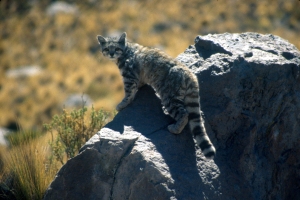Wild Thing is an occasional series where JHU Press authors write about the flora and fauna of the natural world—from the rarest flower to the most magnificent beast.
guest post by James G. Sanderson
 The most endangered cat in all of the Americas is the Andean cat. Found in the high and dry Andes of Argentina, Bolivia, Chile, and Peru, the Andean cat weighs just 10 pounds, no heavier than an ordinary house cat. However, because the Andean cat is found at elevations higher than those of any mountains in the lower 48 states, its fur is especially long, and its tail is long and very bushy. The Andean cat uses its feather-light tail as a scarf, wrapping it around its nose at night.
The most endangered cat in all of the Americas is the Andean cat. Found in the high and dry Andes of Argentina, Bolivia, Chile, and Peru, the Andean cat weighs just 10 pounds, no heavier than an ordinary house cat. However, because the Andean cat is found at elevations higher than those of any mountains in the lower 48 states, its fur is especially long, and its tail is long and very bushy. The Andean cat uses its feather-light tail as a scarf, wrapping it around its nose at night.
Because the Andes are especially dry (it has not rained in 2 1/2 years where I work), the prey of the Andean cat is concentrated near glacier-fed mountain streams. These streams are uncommon and far apart. Thus the Andean cat ranges from stream to stream in search of its prey, mostly mountain viscacha (viz-ca’-cha), small rabbit-like animals that live in large colonies. Consequently, the Andean cat has one of the largest home-ranges of any wild cat, including lions and tigers; for its size and body weight, no other wild cat comes close. One female we captured and radio-collared at 15,500 ft in Bolivia had a home-range of 60km2.
Remarkably, the Andean cat shows no fear of people and does not flee when people are near. Native people living in the high Andes attribute supernatural powers to the Andean cat, but to harness these powers the cat must be killed, desiccated, and elaborately decorated. Conserving a sought-after cultural icon that shows no fear of people is a unique and difficult task. The world’s leading cat specialists consider the Andean cat to be the most threatened in all of the Americas. It is without doubt the rarest cat in the western hemisphere.
 James G. Sanderson is a Fellow of the Wildlife Conservation Network and the founder of the Small Cat Conservation Alliance. He is coauthor of Small Wild Cats: The Animal Answer Guide.
James G. Sanderson is a Fellow of the Wildlife Conservation Network and the founder of the Small Cat Conservation Alliance. He is coauthor of Small Wild Cats: The Animal Answer Guide.


